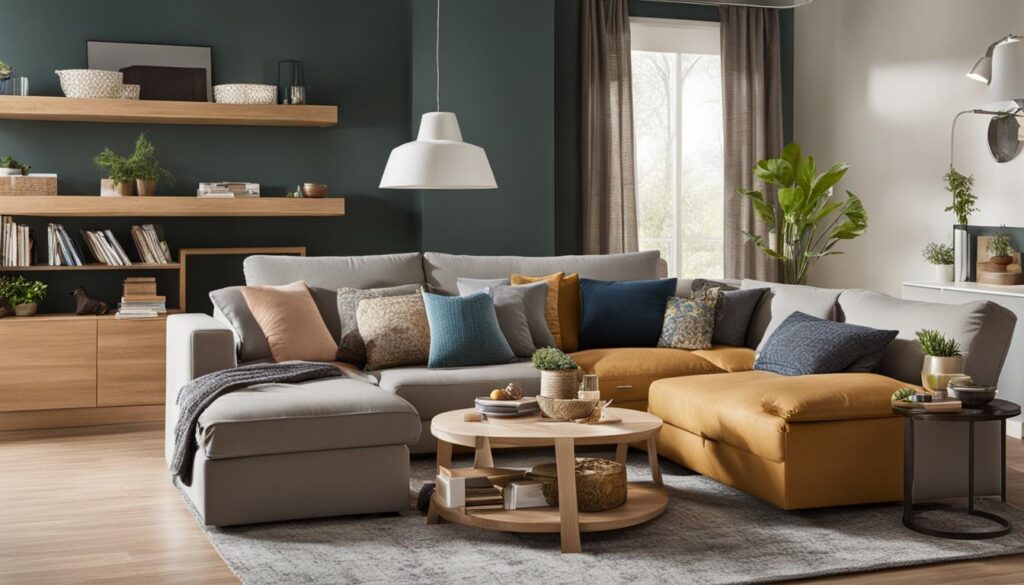As someone who’s extensively embraced the art of living small spaces, I’ve learned that size does not restrict elegance or functionality. The surge in small space living ideas showcases creativity and innovation in designing snug habitats that are both stylish and practical. I’ve been through the journey of transforming a tiny space living situation into a personal retreat that blooms with character and charm.
Throughout my experience living in a small apartment, I’ve grasped the art of apartment therapy small spaces, which is all about maximizing every corner with ingenious solutions. A blend of meticulous small space organization with thoughtful small space design reshapes the limited square footage into an expansive-feeling oasis.
Join me in this guide where we delve into the best practices and insider tips for living in small spaces. Whether it’s chic storage options or multi-functional furniture pieces, maximizing small spaces is achievable. Let’s create a space that is minimalist yet rich, compact yet expansive, and entirely your own.
Key Takeaways for Living Large in a Small Space
- Revolutionize your living area with versatile small apartment ideas that elevate both form and function.
- Learn how to pare down belongings for a minimalist living experience that opens up physical and mental space.
- Discover the value of each square inch and use clever small space organization strategies to maintain order and serenity.
- Transform your living quarters with small space design techniques that make your rooms look and feel more spacious.
- Gather tips for living in small spaces to enhance comfort without compromising on your lifestyle needs.
Embracing Minimalist Living in Tiny Spaces
Discovering the secret to a liberating, clutter-free life begins with a commitment to minimalist living. In the confines of a tiny space, where square footage is like gold, each item we own plays a crucial role in the harmony and functionality of our home. Adopting a minimalist approach isn’t just about creating an aesthetically pleasing environment; it’s about constructing a personal refuge that aligns with our most fundamental needs and values.
Decluttering: The First Step to Spaciousness
My journey into minimalist living kicked-off with the challenging yet rewarding process of decluttering. It’s about sifting through what you have, finding the courage to let go of duplicates, broken items, and those ‘just-in-case’ goods gathering dust. As I delved into each corner, drawer, and closet, I discovered the liberating feeling of donating and discarding items that were merely occupying space. These initial steps in decluttering set the foundation for a spacious and organized living area, an essential element in my goal of downsizing my life.
The Philosophy of Less is More
The mantra of ‘less is more’ became my guiding philosophy, transforming my tiny space from a cramped box into a breathable, serene sanctuary. Minimalist living taught me the art of valuing space over possessions, leading to innovative space-saving solutions and small space hacks that did not only improve functionality but also enhanced the visual appeal of my home. It’s remarkable how a simple shift in thought—prioritizing experience and freedom over material things—can have such a profound impact on lifestyle and contentment.
Choosing Quality Over Quantity
In aligning with a minimalist mindset, I realized the importance of choosing quality over quantity. This meant selecting furniture that serves multiple purposes, providing both utility and style without compromising on space. Every new addition to my home had to meet strict criteria—durability, necessity, and design. It was no longer about how much I could fit into the space but rather how meaningful and functional each item was to my everyday life. Stripping down to the essentials didn’t mean giving up comfort; it meant embracing a curated collection of belongings that genuinely enhanced the quality of my living experience.
The minimalist journey is one filled with intentionality and deliberation, where every choice a small space dweller makes, from the furniture to the decor, contributes to a larger vision of a tidy and tranquil home life. With the wisdom of downsizing tips and embracing minimalist living, I’ve welcomed a newfound appreciation for a simpler, yet infinitely richer way of experiencing my personal environment.
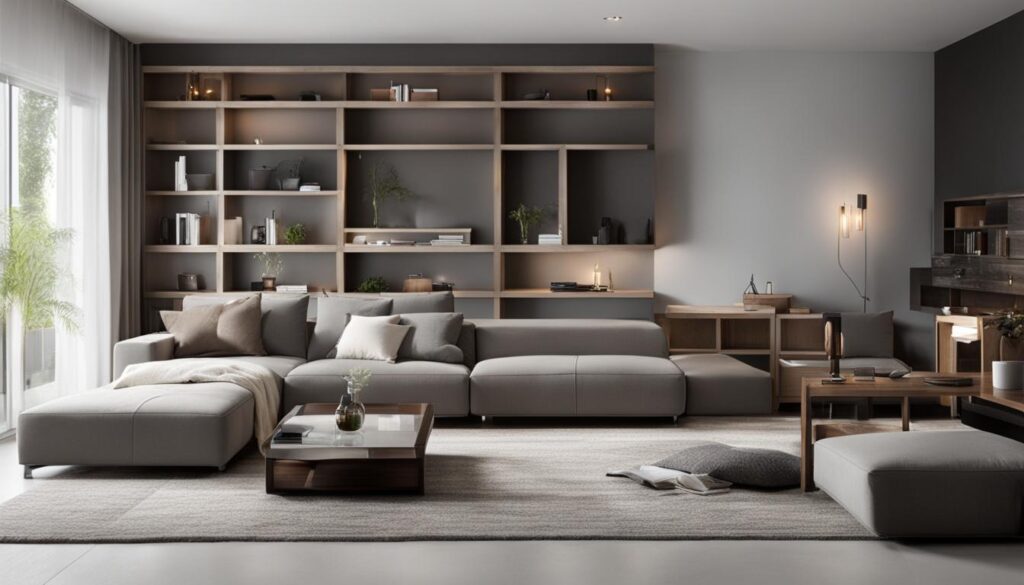

Tackling Smart Storage Solutions
Living the tiny living dream necessitates some ingenuity, especially when it comes to making the most out of my living space. As someone who thrives in a small environment, I’ve learned that the key to maintaining a beautiful and functional home is maximizing small spaces with smart storage solutions. Here are some of the ways I’ve transformed my tiny haven into a model of small space organization and efficiency.
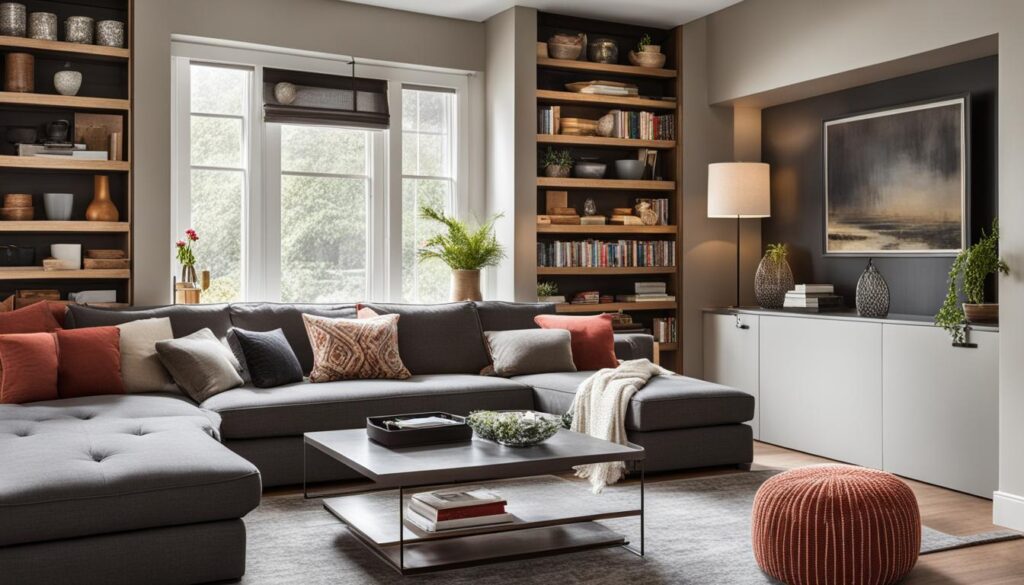

Innovative Use of Vertical Space
The beauty of vertical spaces is often overlooked, but in my home, they are my secret weapon. By installing hanging shelves and hooks, I’ve managed to keep everyday items accessible without sacrificing precious floor real estate. Plants dangle from the ceiling, and kitchen essentials line the walls, lending an airy and organized feel to the place I call home.
Hidden Storage Hacks and Furniture with Dual Purposes
- I adore my storage ottoman; it’s a cozy rest for my feet and a secret stash for my knick-knacks.
- The Murphy bed is my nighttime oasis that disappears by day, leaving ample room for yoga or dance.
- And let’s not forget the small space furniture like sofa beds—perfect for welcoming overnight guests without a dedicated guest room.
Organizational Systems for Every Nook and Cranny
- I assign bins and baskets to miscellaneous items to tame the chaos that comes with restricted space.
- My pantry features tiered shelving so that nothing ever goes missing.
- Underneath my open-faced sink, a curtain conceals cleaning supplies, offering a mix of practicality and charm.
Embracing tiny living means every inch counts, and I’m proud to say that my home stands as a testament to small space solutions done right. By thinking outside the box and using every nook and cranny, my small abode is big on style and functionality.
Small Space Furniture That Makes a Big Impact
As someone who savors the cozy charm of a smaller footprint, I’ve discovered that the right small space furniture can make a monumental difference in both the feel and functionality of my living area. From compact chairs that tuck away after use, to nesting tables that spread their wings when guests arrive, every choice carries weight in a petite dwelling.
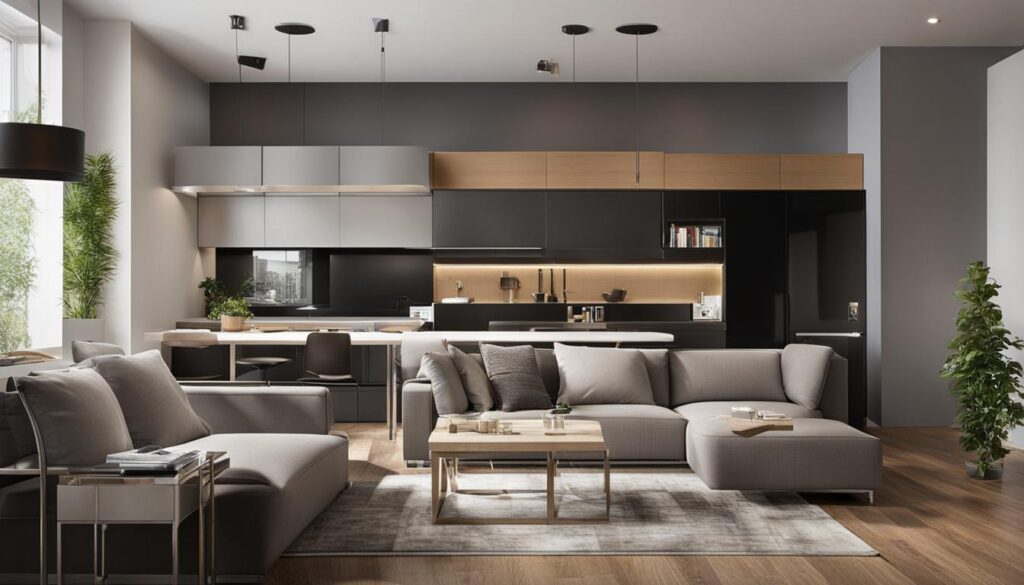

Space-saving furniture isn’t just about being small; it’s about smart design that transcends limited dimensions. Let me share with you some staple pieces that champion utility without forgoing style:
- Drop-leaf kitchen tables: A godsend for tight dining spaces, these tables expand for meals and fold neatly away.
- Storage ottomans: These multitaskers serve as a place to rest your feet, additional seating, and discreet storage repositories.
- Compact chairs: Streamlined in their design, these chairs ensure comfort and can easily be moved or stored when not in use.
- Nesting tables: Sublimely flexible, they sit quietly in one corner and become dynamic when called into action for drinks, laptops, or plants.
- Wall desks: These space-conscious desks afford you a workspace that folds up into a sleek wall fixture when your tasks are done.
When selecting small apartment furniture, it’s not just about the physical space it occupies, but also the visual space. I opt for pieces that breathe lightness into a room, maintaining a sense of openness. It’s a dance between dimensions and desire, ensuring each selection serves multiple purposes without overwhelming my treasured space.
Design Strategies for a Spacious Feel
When I tackle small space design, I always focus on creating an atmosphere that feels open and uncluttered. The right design strategy can transform a compact interior into a comfortable, expansive-feeling oasis, using clever tips for living in small spaces, including color choices, reflective elements, and thoughtful arrangements that channel both minimalist lifestyle principles and feng shui design methodology.
Color Tactics: Using Light Hues to Open Up a Room
My first step in cultivating spaciousness is figuring out how to choose paint colors. Light hues are my go-to because they make walls seem to recede, expanding the room visually. Soft shades of blues, greens, and off-whites not only reflect natural light to create a breezy vibe but also set a tranquil tone that aligns with a minimalist aesthetic.
Mirrors and Reflective Surfaces to Expand Visual Space
There’s no denying the power of mirrors in enhancing the sense of space. By strategically placing mirrors across from windows, I provide a double-vision effect, magnifying light and views, which magically makes rooms appear larger than they are. Reflective metals and glossy finishes on furniture or decor also play roles in this visual expansion—each offering a shimmer that tricks the eye.
Furniture Arrangement: Flow and Accessibility
When arranging furniture, I focus on ensuring there’s a natural flow. Furniture should facilitate movement rather than hinder it, with clear pathways that invite exploration and interaction. Incorporating feng shui design principles, I aim for a balanced, intentional layout that also subscribes to a minimalist lifestyle—each piece of furniture is not just functional but essential, and there’s nothing superfluous to obstruct the room’s energy or accessibility.
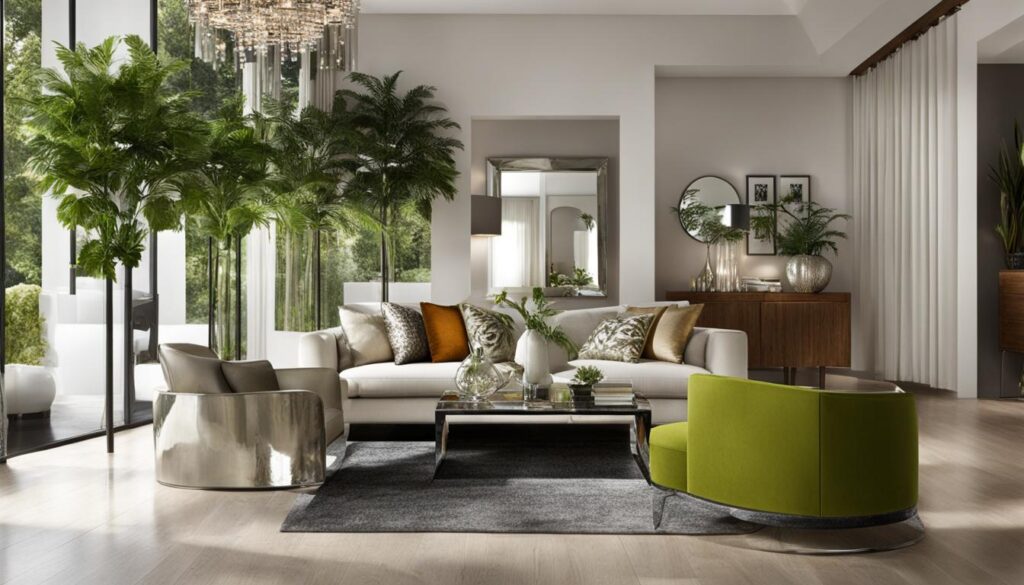

Living Small Spaces: Tips for Making the Most of Your Area
As I’ve embraced the world of tiny living, I’ve learned that every inch counts. Here’s a thing or two about transforming underused nooks into vibrant, useful areas. Corners, for example, are often overlooked, yet they are secret treasures in small spaces—I’ve seen them converted into cozy reading nooks with just the right corner shelving.
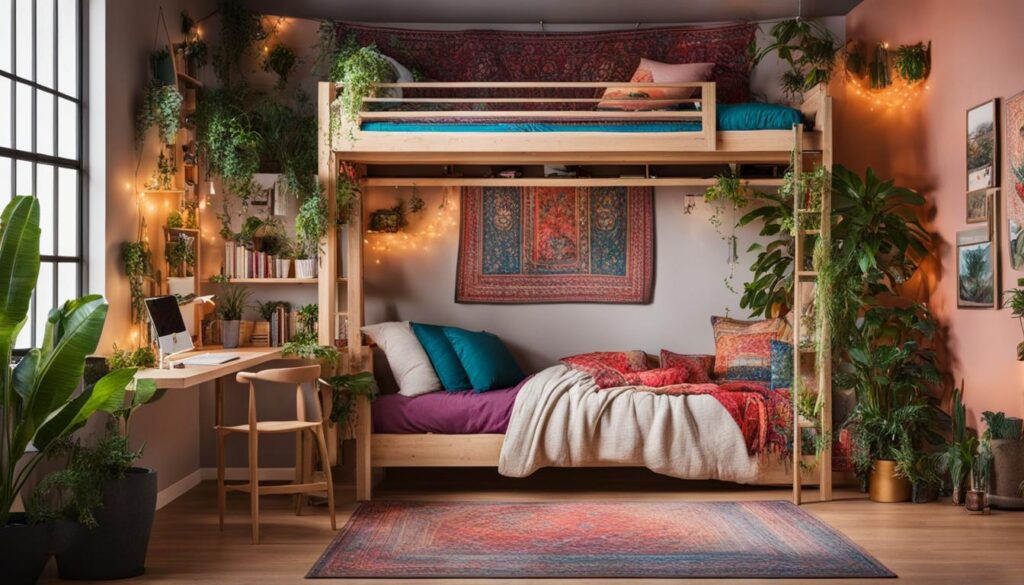

Transforming Corners into Functional Spaces
Who says corners are just for spiderwebs? I say, make them work for you! With creative small space hacks, that awkward angle can become a centerpiece for storage or work.
- Invest in a triangular desk that fits snugly, maximizing your workspace
- Use corner floating shelves to display your cherished collectibles or store books
- Add a slim, vertical coat rack to make a mini mudroom
Utilizing Multi-Functional Features and Foldable Furnishings
Every piece of foldable furniture I’ve added to my home has been a game-changer. Whether it’s a Murphy bed that transforms my studio from bedroom to living room, or a collapsible dining table that gives me space to entertain, space-saving solutions are the hallmarks of smart design.
- Choose a foldable kitchen island that can move away when you need extra floor space
- Opt for a wall-mounted desk that folds up to clear the room for exercise or play
Adjusting Layouts to Suit Lifestyles
I’ve always found adjusting my layout to be an ongoing process, dictated by the need of the moment. With versatile small space furniture, the same room can be an office by day and a lounge by evening. It’s all about being adaptable and welcoming change.
- Rearrange seating for social events to encourage good flow and conversation
- Sometimes, simply turning a bookcase or bed to a different orientation opens up new possibilities
By utilizing these downsizing tips and adaptable furnishings, I cherish the coziness of my personalized living situation, proving that you don’t need a mansion to live large—it’s all about making smart use of what you have.
Maximizing Small Spaces: From Kitchen to Closet
When it comes to small space living, I’ve found that the key to creating a functional and stylish home is cleverly utilizing every square inch. Whether it’s by incorporating small space organization techniques or finding those ingenious tips for small space living, there’s always a way to make the most of your cozy quarters.
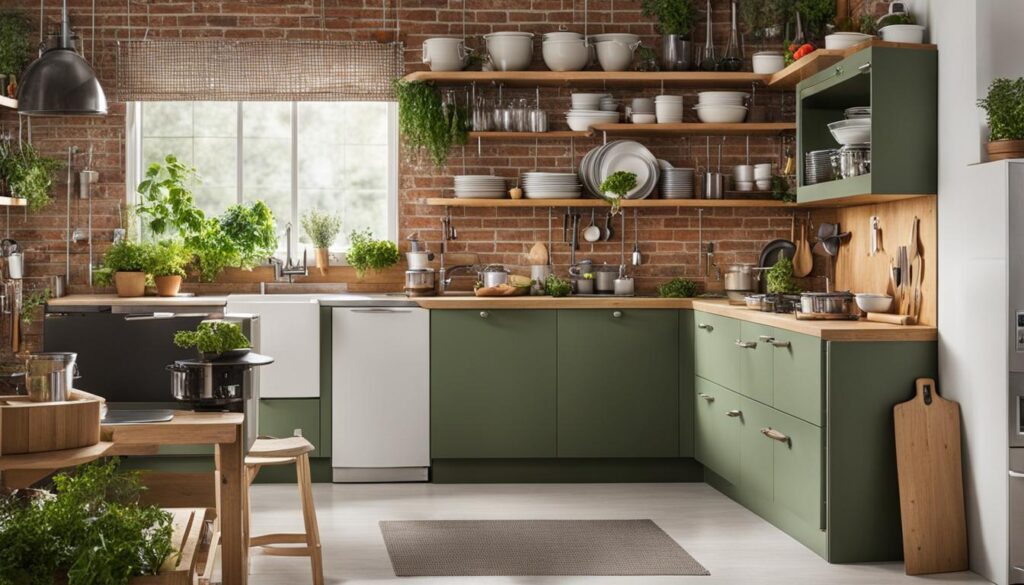

Let’s start with the kitchen. It’s often said to be the heart of the home, but in a compact living scenario, it can feel cramped. One of my favorite tiny living hacks is a rolling kitchen island. It provides extra counter space when I’m whipping up a meal and can be easily tucked away when not in use.
Additionally, pullout cabinets have changed the game for me. You wouldn’t believe the amount of cookware and ingredients that can be neatly stored in these space-savers. And the best part? Everything is within arm’s reach without cluttering the countertops. For those who practice apartment therapy small spaces concepts, it’s a total win-win.
- Rolling kitchen islands for flexible counter space
- Pullout cabinets for efficient storage
- Wall-mounted racks to keep utensils handy
In the bedroom, an exposed closet not only makes my clothes easily accessible but also becomes a display that adds character to the room. Wall-mounted shelving does wonders too, giving me a place to show off treasures while keeping the floor clutter-free.
- Use a clothing rack to create an open closet concept
- Install floating shelves for decorative storage
- Choose multi-purpose furniture like a storage bed
Each adaptation reflects the ingenuity and creativity that small space living demands. It’s not just about making things fit—it’s about crafting a space that’s as unique and functional as it is cozy and inviting. A living space that works for you, not against you, regardless of its size.
Conclusion
The art of living in a small apartment is both a challenge and a journey, one where each square foot can be a reflection of creativity and efficiency. I’ve discovered through personal experience that a small space living arrangement demands not just adaptation to the physical constraints but also an embrace of a minimalist ethos, where each belonging is purposeful and each design choice intentional. Indeed, the beauty of living small spaces lies in the craftsmanship of constructing a life unburdened by excess and anchored in simplicity.
Embracing the Beauty of Living Small
My journey toward a tiny space living lifestyle opened my eyes to the aesthetics of minimized living. As I delved deeper into the process, the benefits became increasingly apparent. The coziness of a well-arranged room, the triumph of clever storage solutions, and the tranquility that comes from an uncluttered space. These elements coalesce into a serene living environment that not only saves space but elevates it to an expression of personal style and practicality.
Continual Adaptation and Creativity in Tiny Living
Adaptability has been my companion as I navigated the labyrinth of small apartment ideas and organizational tricks. From multifunctional furniture to the strategic use of colors and textures, my abode has become a testament to the ingenuity that tiny living demands. It’s a dynamic process, one where I remain ever ready to tweak and improve every nook and cranny to support a life full of passion and purpose.
The Journey to a Clutter-Free, Spacious Existence
The ultimate goal, which I pursue daily, is the achievement of a clutter-free existence. This doesn’t simply mean fewer possessions but the cultivation of space that breathes and aids in the pursuit of my passions. It’s a continuous expedition toward spaciousness, both physically and mentally, that reinforces my belief in the richness of small space living. Every day brings new lessons and possibilities, ever encouraging me to live larger within my cozy confines.
FAQ
How do I manage to live comfortably in a smaller space?
Living comfortably in a smaller space is all about utilizing smart space-saving solutions, choosing multi-functional furniture, and staying organized. Declutter regularly to keep your space open and opt for furniture that can serve multiple purposes to make the most of your area. Embrace minimalist living principles to reduce the number of items you own and focus on quality over quantity.
What are some effective small space living ideas?
Effective small space living ideas include using vertical storage to free up floor space, opting for furniture with hidden storage, and selecting pieces that can be folded or stored away easily when not in use. Experiment with light color palettes for walls and furnishings to help make rooms feel more spacious and use mirrors strategically to create the illusion of a larger space.
How can I organize my small apartment to maximize space?
To organize your small apartment, think vertically by using wall-mounted shelves and hanging storage. Invest in dual-purpose furniture like ottomans with built-in storage or Murphy beds that fold up when not in use. Utilize organizational systems like bins and baskets to maintain tidiness, and be sure to utilize corners and underutilized spaces with corner shelving or foldable desks.
What furniture should I choose for my tiny apartment?
For a tiny apartment, choose furniture that is proportional to your space and serves multiple functions. Look for compact chairs, nesting tables that can be stored neatly when not needed, and drop-leaf tables that can be expanded for dining. Select furniture with exposed legs for a sense of openness. Additionally, consider investing in convertible furniture like sofa beds to accommodate guests without requiring extra space.
Can you provide downsizing tips for someone transitioning to small space living?
Sure! Downsize by starting with decluttering all of your belongings, removing items that you no longer use or need. Sell, donate, or recycle these items responsibly. Try curing your possessions to what’s essential, focus on the quality of items, and not the quantity. Multifunctional and collapsible items are your friends – consider a table that folds away or a bed with storage built in. Remember to be consistent with clearing out and keep an eye on new acquisitions to prevent clutter from building up again.
What color tactics can I use to make my small space seem bigger?
To make your small space seem bigger, use light hues such as whites, light grays, and pastels which can reflect more light and make the room feel airier. Stick to a simple color palette to avoid visual clutter, and consider using a monochromatic scheme to create a seamless look. Paint ceilings a lighter color than walls to draw the eye upwards and create the illusion of height.
How do I select paint colors for my small space to maximize its feel?
When selecting paint colors for your small space, aim for light and neutral colors to maximize the sense of space. Soft tones like off-white, beige, and light gray can open up a room and enhance the natural light. If you crave color, consider using it on a single accent wall or through accessories to add vibrancy without overwhelming the space. Don’t forget to paint the ceiling a shade lighter than the walls to create the feeling of height.
Are there any furniture arrangement tips for small apartments?
Absolutely! When arranging furniture in a small apartment, focus on creating a clear pathway to ensure easy flow and movement. Keep the space open by selecting furniture that fits the scale of the room without obstructing walkways. Aim for a layout that promotes both function and comfort. For instance, placing your sofa against a wall can maximize the living area, and using round tables can help with the flow since they don’t have sharp corners.
What multi-functional furniture pieces are best for space-saving?
The best multi-functional furniture pieces for space-saving include sleeper sofas, ottomans with storage, extendable dining tables, and Murphy beds. Items like nesting tables and stackable chairs are also great as they can be easily moved or tucked away. Look for pieces that can adapt to different needs, like a desk that can fold out from a wall or kitchen carts that provide extra counter space and storage.
How can I make my small closet more functional?
To make your small closet more functional, start by decluttering your wardrobe to free up space. Use multi-level hangers to store more items vertically, and introduce shelf dividers to keep stacks of clothing neat. Incorporate hanging organizers, over-the-door storage, and bins to maximize the closet’s depth and height. Lastly, using vacuum-sealed bags can help compress off-season clothing and linens to take up less space.

